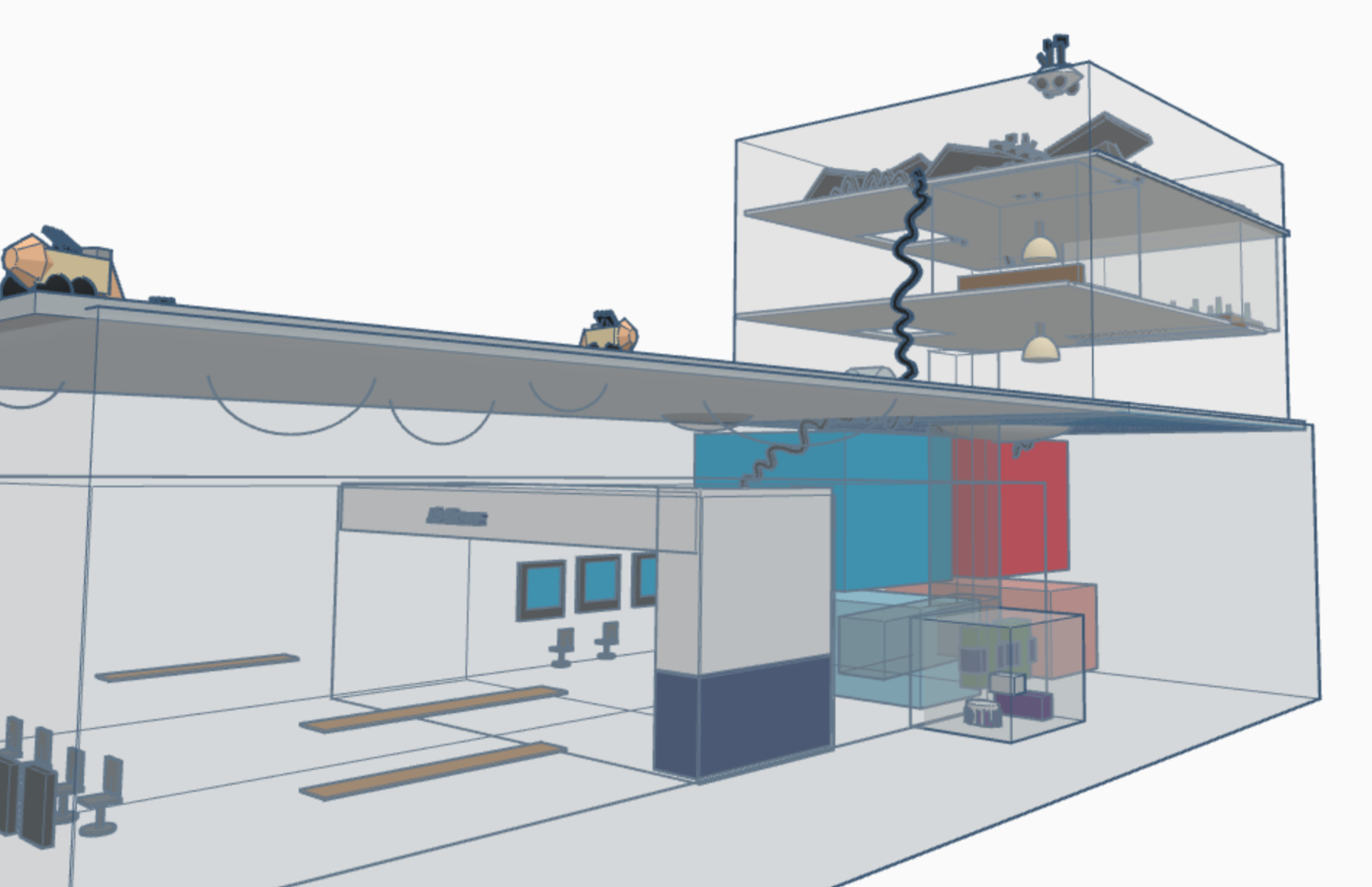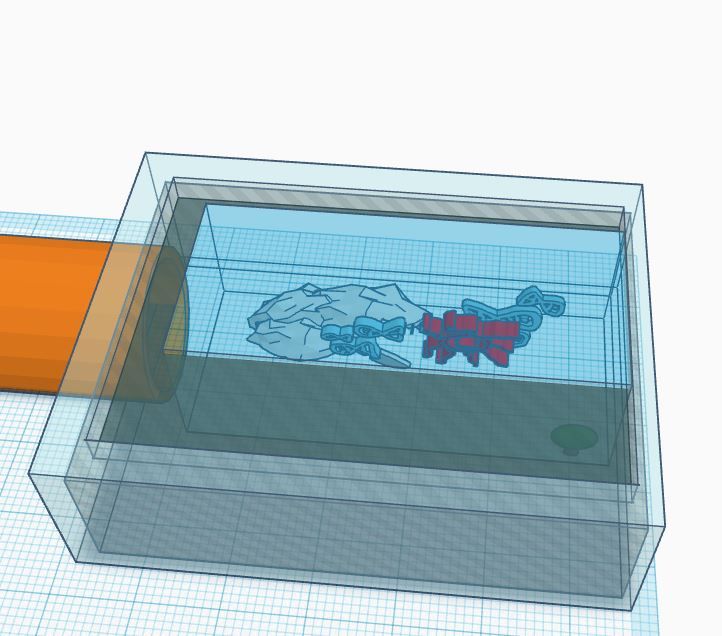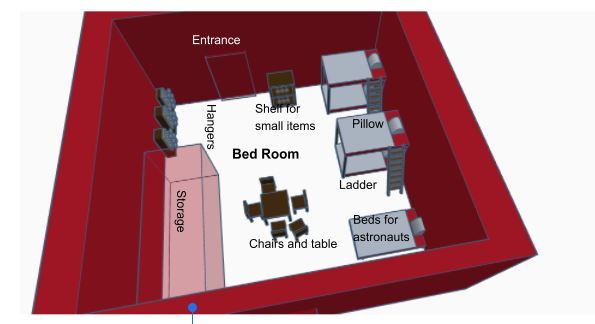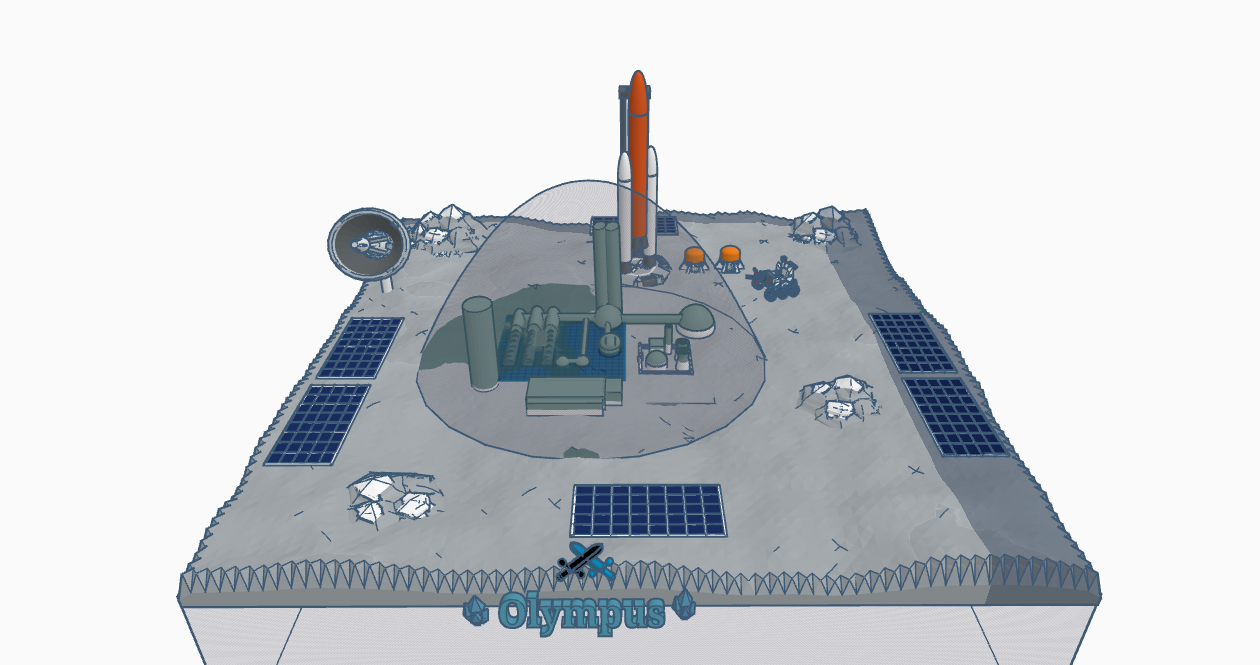Moon Camp Explorers Gallery 2021-2022
In Moon Camp Explorers each team’s mission is to 3D design a complete Moon Camp using Tinkercad. They also have to explain how they will use local resources, protect astronauts from the dangerous of space and describe the living and working facilities.
Team: Leni and Prudy
Sycamore School Indianapolis United States 11, 10 2 / 2
External link for 3d
|
Project description
One of the main goals is to utilize as many natural resources from the moon for sustainability. For example, we will build our shelter close to the South Pole where ice-water can be retrieved for water and oxygen can be retrieved from lunar dirt through electrolysis so traveling time is minimal. Our shelter will be built on top of one crater (less work on digging) which serves as water storage/pool. We also plan to build a solar energy system with a heat exchange for power. Another goal is to bring as few materials to the moon as possible. For example, we bring a 3D printer so we can use the materials retrieved from lunar for printing needed equipment and tools. This will avoid dependency on having our headquarter to bring us critical needs. If we get lucky, we hope to retrieve precious metals such as platinum, uranium and gold. We also plan on building the Advanced Plant Habitat which is a growth chamber on station not only for plant research but also as food supply so we don’t need to worry about running out of food. Above all, we also hope this Moon Camp project will provide invaluable information for future improvements and expansions for more sustainable and livable space habitats such as having more self-sufficient energy like Helium-3 which can be used for powering other space stations and will reduce unnecessary space trips to provide fuel in space. Limitation: This is done with assumption of earth gravity. |
||||
|
Where do you want to build your Moon Camp?
Close to the lunar poles Why did you choose this location?
We will build our moon camp near the South Pole because according to NASA, it is the best spot for ice and other mineral resources. Water is a necessity for furthering human exploration because it could potentially be used for drinking, cooling equipment, breathing and making rocket fuel for missions farther into the solar system. Other extremes at the Moon’s South Pole are not so dark and cold with some areas that are bathed in sunlight for extended periods of time which allows us to harvest sunlight in order to light up a lunar base and power the equipment. How do you plan to build your Mooncamp? Which materials will you use?
Shelter will be built near the South Pole where the temperatures are relatively suitable for humans with shorter distances for ice water retrieval. Rovers first dig the ground with a passage going underground into a living space, lunar toilet with a trash compactor, research lab with air shower, cold sink and hot sink for water. Polyethylene will be used to build a cube-like structure with an airtight door and walls above the ground with three levels with oxygen supply: |
||||
|
Water
|
Food
|
Electricity
|
Air
|
Protection
|
|
Water can be retrieved from both poles where we must be mined to obtain water from pools of ice-water. We will first retrieve from the South Pole as it’s closer to our shelter. We will send rovers to locate icy spots. After that, the rovers will fire up and blast lunar dirt and gravel into their vacuum-like devices in which water will be separated and stored the water particles. For future water sources, we will explore potential water recycles from wastes (e.g. with NASA technology of capturing up to 85% of water from urine and 92% of waste moisture). |
When astronauts venture farther into space, feeding the astronauts presents several unique challenges. The Advanced Plant Habitat is a growth chamber on station for plant research and food supply. It uses LED lights and a porous clay substrate with controlled release fertilizer to deliver water, nutrients and oxygen to the plant roots. Another new method is to grow bigger plants in space which uses units that are less expensive to produce, have more water holding capacity, provide a greater space for root growth and are a completely passive system. |
A scalable solution to lunar habitats would involve a heat exchange system comprising multiple mirrors, processed lunar soil, a heat engine and heat pipes. During the day, the engine can be run directly from the solar energy provided by the Sun, which simultaneously also stores excess heat in the thermal mass. At night the heat engine keeps running by the release of the energy from the thermal mass. The cold sink and the hot sink are located underground in the loose regolith level. |
In order to collect oxygen, we must collect lunar soil and use electrolysis on it. In order to do so, we must use a method called molten salt electrolysis, involving placing regolith in a metal basket with molten calcium chloride salt to serve as an electrolyte, heated to 950°C. via solar energy. After applying electrical current, it will extract the oxygen, and migrate the salt to an anode, where it can be easily removed. In addition, the metal left behind is usable. |
Moon temperature fluctuates due to lack of atmosphere. Astronauts can enjoy soaking in a big pool of water (mined from moon poles) during daytime horrendous heat and radiation while keeping warm in freezing nights with a heat exchange system comprising mirrors, processed lunar soil, heat engines and heat pipes. For meteorites prevention, smart robots will be used for detecting and shooting possible big meteors because some meteors can be the size of a house. |
|
Describe a day on the Moon for one of your Moon Camp astronauts
The feeling of homesickness strikes me the moment after I wake up. Being one of the two humans on the moon, it’s hard not to miss friends and family back home, not to mention the convenience of delicious food delivered by Doordash. Here on the moon, we have to work for oxygen, water, food and power. Well! I am here and ready for my astronaut day! First thing in the morning before brushing my teeth and having my carrot breakfast, my partner and I need to do our daily tasks rundown: Ensure the oxygen level is set properly As the robots are ready, we slap on our helmets and suits and send our robots out to do their jobs. While I monitor the water retrieval robots, my partner monitors the oxygen retrieval robots. After enjoying salad for lunch and cooling off in the pool while having some exercises, we put on our helmets and suits again to welcome our robots back from a hard working day. We clean and check the robots to ensure they are in order before we write up evening reports. After enjoying a relaxing dinner and watching YouTube in the evening, it’s bedtime. Night out! |
||||









